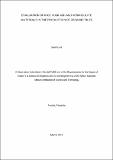| dc.description.abstract | The challenging issues in ceramic tiles are low mechanical strength, thermal discomfort and
high production costs. Apart from strength the technical functions of floor tiles based on
thermal insulation is very important in buildings with human occupation where thermal
comfort is required. The objective of this work was to investigate the potential of rice husk
ash (RHA) and vermiculite materials in production of ceramic tiles. Initially, a typical
ceramic body composed of the mixture of vermiculite and RHA batched with clay, feldspar,
quartz and kaolin was prepared. Ceramic bodies were then obtained from this ceramic
mixture by pressing samples at a forming pressure of 35 MPa. These bodies were then fired
at 1180°C in a laboratory furnace and finally the changes in the physical and mechanical
properties caused by the introduction of vermiculite and RHA were tested and evaluated. The
chemical composition of the raw samples was analysed by X-ray fluorescence (XRF) while
the phase composition was investigated using X-ray diffraction (XRD). The morphology of
the powdered samples was studied by using Scanning electron microscopy (SEM). The bulk
density and open porosity of the sintered ceramic bodies were evaluated using Archimedes
‘principle while the flexural rupture strength was determined by the three point bending test
method. The major chemical compounds in vermiculite raw sample were SiO2, Al2O3 and
Fe2O3 while RHA sample was found to contain mainly SiO2. From the XRD analysis,
vermiculite sample had crystalline vermiculite while RHA sample had amorphous silica at
low temperature below 900oC and crystallized (tridymite) above 900oC. The results from
physical, mechanical and thermal properties tests show that with addition of vermiculite and
RHA, the percentage of porosity, water absorption, linear shrinkage and thermal insulation
capacity were increasing while the bulk density, bending strength, thermal conductivity and
effusivity of the fired ceramic bodies decreased. Among the studied compositions apart from
the reference sample, tile bodies made from blend containing 20 wt. % vermiculite, 5 wt. %
RHA and fired at 1180oC were found to have the best properties for the production of
ceramic tiles. For this combination the values for water absorption, porosity, and linear
shrinkage, bulk density, bending strength, thermal conductivity and effusivity were 7.60 %,
12.08 %, 3.29 %, 1.88 g/cm3, 18.54 MPa, 0.82 W/m.K, and 1284.33 W1/2/m2K4 respectively.
These values were close to the required standards for wall and floor tiles applications. This is
an indication that vermiculite and RHA are suitable raw materials for the production of
ceramic tiles with a required strength and thermal comfort. | en_US |

